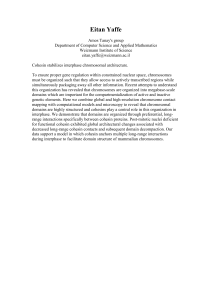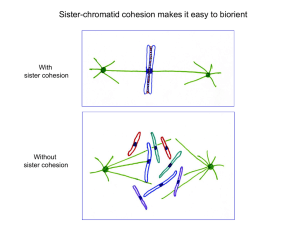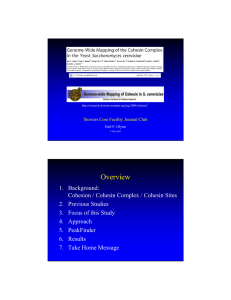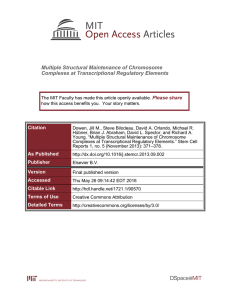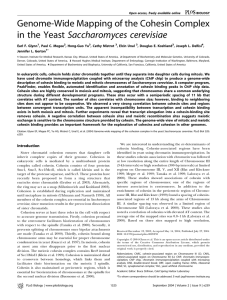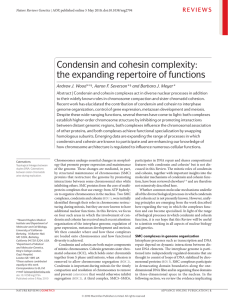version 1 - UBC Blogs
advertisement
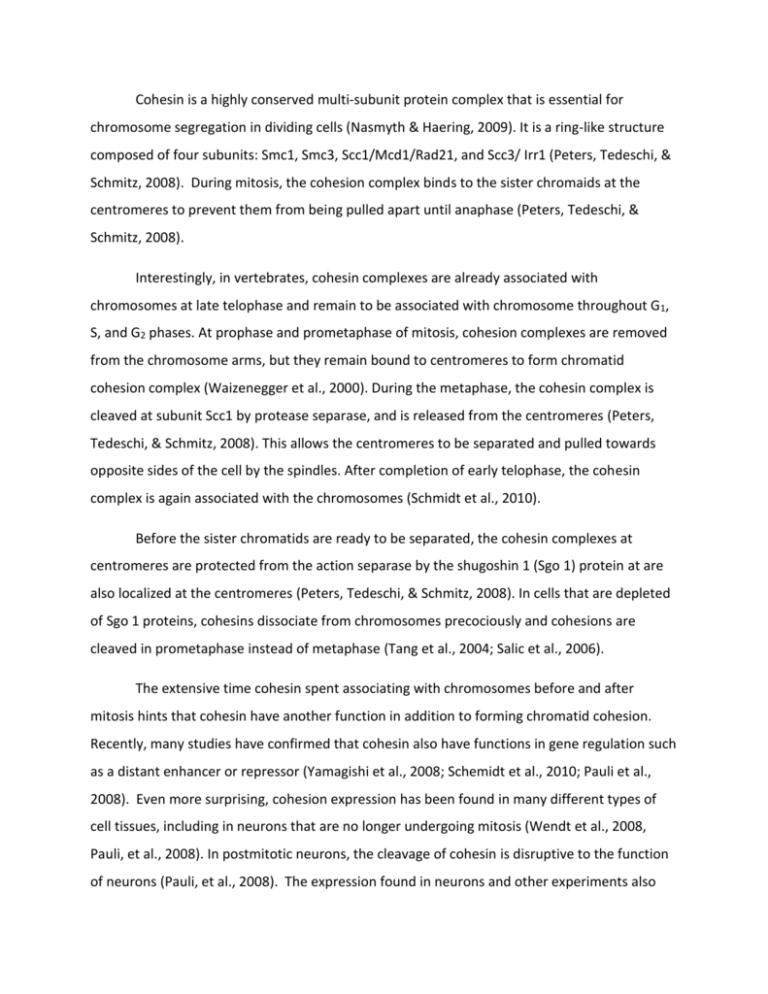
Cohesin is a highly conserved multi-subunit protein complex that is essential for chromosome segregation in dividing cells (Nasmyth & Haering, 2009). It is a ring-like structure composed of four subunits: Smc1, Smc3, Scc1/Mcd1/Rad21, and Scc3/ Irr1 (Peters, Tedeschi, & Schmitz, 2008). During mitosis, the cohesion complex binds to the sister chromaids at the centromeres to prevent them from being pulled apart until anaphase (Peters, Tedeschi, & Schmitz, 2008). Interestingly, in vertebrates, cohesin complexes are already associated with chromosomes at late telophase and remain to be associated with chromosome throughout G1, S, and G2 phases. At prophase and prometaphase of mitosis, cohesion complexes are removed from the chromosome arms, but they remain bound to centromeres to form chromatid cohesion complex (Waizenegger et al., 2000). During the metaphase, the cohesin complex is cleaved at subunit Scc1 by protease separase, and is released from the centromeres (Peters, Tedeschi, & Schmitz, 2008). This allows the centromeres to be separated and pulled towards opposite sides of the cell by the spindles. After completion of early telophase, the cohesin complex is again associated with the chromosomes (Schmidt et al., 2010). Before the sister chromatids are ready to be separated, the cohesin complexes at centromeres are protected from the action separase by the shugoshin 1 (Sgo 1) protein at are also localized at the centromeres (Peters, Tedeschi, & Schmitz, 2008). In cells that are depleted of Sgo 1 proteins, cohesins dissociate from chromosomes precociously and cohesions are cleaved in prometaphase instead of metaphase (Tang et al., 2004; Salic et al., 2006). The extensive time cohesin spent associating with chromosomes before and after mitosis hints that cohesin have another function in addition to forming chromatid cohesion. Recently, many studies have confirmed that cohesin also have functions in gene regulation such as a distant enhancer or repressor (Yamagishi et al., 2008; Schemidt et al., 2010; Pauli et al., 2008). Even more surprising, cohesion expression has been found in many different types of cell tissues, including in neurons that are no longer undergoing mitosis (Wendt et al., 2008, Pauli, et al., 2008). In postmitotic neurons, the cleavage of cohesin is disruptive to the function of neurons (Pauli, et al., 2008). The expression found in neurons and other experiments also demonstrate that cohesin’s function in transcriptional control is independent of its role in sister chromatid cohesion (Pauli, et al., 2008; Yamagishi, et al., 2008). Although the cohesin’s function in gene regulation has been found in several model animals and in many types of tissues, what other factors are associated with cohesion remain unknown. In a recent study, Chetaille et al. (2014) found that a single nucleotide mutation within exon 1 of Shugoshin-like 1 (SGOL 1, human) causes Chronic Atrial and Intestinal Dysrhythmia (CAID syndrome) in human. The fibroblast cultures from the patients that carry homozygous SGOL1 mutation had faster cell proliferation compared to control and centromeres of sister chromatids were separated at metaphase (Chetaille et al., 2014). In addition, there were mislocalization of enteric ganglia and Cajal cells (gut pacemaker cells) in the circular and longitudinal smooth muscle layers (Chetaille et al., 2014). Curiously, the Sgol1 was strongly expressed in enteric neurons (Chetaille et al., 2014). This suggests that perhaps that SGOL1 or SGO1 also partake in the long-range transcriptional regulation. I hypothesize that in additional to Sgo1 protein’s role in protecting centromeric cohesin from separase cleavage during early phases of mitosis, Sgo1 protein also helps regulate cohein’s gene regulation of other genes. Specifically, I hypothesize that in Drosophila melanogaster ɣ neurons, Sgo1 expression is essential for cohesin’s function in axonal pruning, and this function of Sgo1 in also independent of its function at centromere. To test this hypothesis, a strain of Sgo1 mutant that have normal Sgo1 expression unless induced needs to be developed. This allows normal neural development at early stage and detection of changes in postmitotic neurons after the Sgo1 knockout is induced. As similar to the experiment done by Paulie et al. (2008), a transgenic fly is express tobacco etch mosaic virus (TEV) protease linked to a heat-shock promoter. In this system, heat shock will induce the activation of TEV which will cleave Sgo1, thus knocking out Sgo1. The advantage of this system is that it allows testing of Sgo1 in vivo and at desired time. The general concept is that the Sgo1-TEV mutant larvae will allowed for normal growth until neuron matures (postmitotic neurons). Then heat shock will be given to activate TEV protease. Then immunostaining will be done on neurons to observe for abnormalities. We will focus on the postmitotic axons of ɣ neurons which are located in the mushroom body of the brain (Pauli et al., 2008). During metamorphosis of the fly, ɣ neurons undergo selective elimination of its projections in a process called “axonal pruning” (Pauli et al., 2008). It has been previously found that cohesin normally are present in the ɣ neurons, and when the cohesin complex is knocked out (by cleaving off one of its subunit), the ɣ neurons lost the axonal pruning process (Pauli et al., 2008). In our Sgo1-TEV mutant, when activated, the Sgo1 protein should be cleaved and lose its ability to be associated with cohesin. The cohesion would be destabilized, and this would decrease the pruning process (i.e., the number of projections on ɣ neurons remains relatively high). However, there still might be some basal level of pruning activities because cohesion is still functional. A treatment of Sgo1-TEV and cohesion knock-out would likely result in complete abolishment of axonal pruning (i.e., high amount of projections on axons not eliminated), much similar to the result cohesion knock-out single mutant (Pauli et al., 2008). A control of Sgo1 and cohesion WT and a control of Sgo1-TEV without heat shock will be performed along side of the mutant treatment at every step for comparison. Both controls are expected to have normal pruning process. To view the image of the axonal projections, the actins and microtubules of the ɣ neuron axon will be immunostained. If my hypothesis is correct, then we show that the Sgo1 protein is necessary for the cohesion to function properly in ɣ neurons of Drosophila. However, if my hypothesis is incorrect, then I would expect that Sgo1-TEV treatment group would have normal pruning comparable to the controls, and the double mutant of Sgo1-TEV and cohesion knockout would still have disrupted pruning. Then, perhaps other co-factors are associated with cohesin complex, or none at all. Reference Chetaille, P., Preuss, C., Burkhard, S., Cote, J.M., Houde, C., Castilloux, J.,… Andelfinger, G. (2014). Mutations in SGOL1 cause a novel cohesinopathy affecting heart and gut rhythm. Naure, 46, 1245-1249. Nasmyth, K. & Haering, C.H. (2009). Cohesin: Its roles and mechanisms. Annual Review of Genetics, 43, 525-558. Pauli, A., Althoff, F., Oliveira, R.A., Heidmann, S., Schuldiner, O., Lehner, C.F.,… Nasmyth, K., (2008). Cell-type-specific TEV protease cleavage reveals cohesin functions in drosophila neurons. Developmental Cell, 14, 239-251. Peters, J.M., Tedeschi, A., & Schmitz, J. (2008). The cohesin complex and its roles in chromosome biology. Genes & Development, 22 (22), 3089-3114. Salic, A., Waters, J.C., & Mitchison, T.J. (2004). Vertebrate shugoshin links sister centromere cohesion and kinetochore microtubule stability in mitosis. Cell, 118, 567-578. Schmidt, D., Schwalie, P.C., Ross-Innes, C.S., Hurtado, A., Brown, G.D., Carroll, J.S., …Odom, D.T. (2010). A CTCF-independent role for cohesion in tissue-specific transcription. Genome Research, 20(5), 578-588. Tang, Z., Shu, H., Qi, W., Mahmood, N.A., Cumby, M.C., & Yu, H. (2006). PP2A is required for centromeric localization of Sgo1 and proper chromosome segregation. Developmental Cell, 10, 575-585. Waizenegger, I.C., Hauf, S., Meinke, A., & Peters, J.M. 2000. Two distinct pathways remove mammalian cohesion from chromosome arms in prophase and from centromeres in anaphase. Cell, 103, 399-410. Wendt, K.S., Yoshida, K., Itoh, T., Bando, M., Koch, B., Schirghuber, E., … Peters, J.M. (2008). Cohesin mediates transcriptional insulation by CCCTC-binding factor. Nature, 451, 796801. Yamagishi, Y., Sakuno, T., Shimura, M., & Yoshinori W. 2008. Heterochromatin inks to centromeric protection by recruiting shugoshin. Nature, 455, 252-256.
